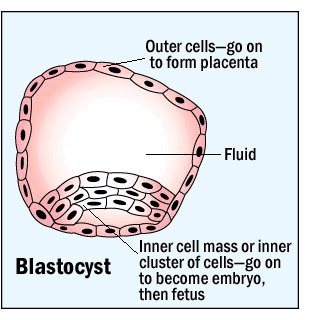Veto of Stem Cell Bill Shows Moral Courage
Friday, July 21, 2006Audio version:
President George W. Bush should be applauded for his July 19, 2006, veto of the embryonic stem cell research funding bill. He has had the courage to do the right thing despite tremendous political pressure.
 Embryonic stem cells are extracted from blastocysts, which are destroyed in the process, about five days after conception by in vitro fertilization (IVF). In other words, a new human life is conceived and then killed after a few days to obtain its stem cells. President Bush is right: to condone, encourage, or even fund such killing is crossing a moral line that should be unacceptable to everyone.
Embryonic stem cells are extracted from blastocysts, which are destroyed in the process, about five days after conception by in vitro fertilization (IVF). In other words, a new human life is conceived and then killed after a few days to obtain its stem cells. President Bush is right: to condone, encourage, or even fund such killing is crossing a moral line that should be unacceptable to everyone.
This brings up yet again the definition of when life begins that has been discussed ad nauseum in the pro-life/pro-choice battles since before Roe v. Wade legalized most abortions in 1973. Pro-choice advocates have held that life begins at birth while pro-life advocates point to conception as the moment life begins.
Roe decided upon a mediating position, focusing on viability, the point at which a fetus can survive outside the womb. It held that for abortions during the first trimester, the state's only compelling interest is to ensure that abortions are performed by a licensed physician in a clinical setting. In the second trimester, the state's additional interest is to protect maternal health. During the third trimester, or after viability, whichever comes first, the state may restrict abortions to those women whose lives are endangered by a continuation of their pregnancies.
In the three decades since Roe, prenatal medical advances have pushed viability closer and closer to conception, rendering Roe's standards obsolete. Many children are born today as a result of IVF and later implantation of the fertilized ovum into the womb of either the donor mother or a surrogate mother. About 22% of IVFs result in live births.
The pro-life position on when life begins is simple: when conception occurs, the resulting embryo is a unique human, genetically indistinguishable from a newborn baby, and it is definitely alive. All that happens after that is added nutrition and growth. To end that life for whatever reason is morally wrong. Certainly we don't want to start up an industry devoted to creating human life only to destroy it while harvesting its components to use as "spare parts."
The Bible affirms the value of human life by pointing to God as its source. All human beings derive their lives from the original couple, Adam and Eve, whose own lives came directly from God Himself (Genesis 1:26-27; 2:7, 21-23; 5:1-2). It recognizes the continuity between prenatal and neonatal existence (Psalm 139:13-16; Jeremiah 1:4; Luke 1:41-45).
Do alternatives exist?Stem cell research offers many promising approaches to curing diseases such as cancer, Parkinson's Disease, diabetes, heart disease, spinal cord injury, and liver failure. Do we turn our backs on the millions suffering from these debilitations by opposing factory-like production of embryonic stem cells that kill fertilized ova? No!
A number of alternatives exist for obtaining embryonic stem cells, including lines being grown in the laboratory, cells harvested from umbilical cord blood (formerly discarded after births, but now collected in a growing number of hospitals), cells retrieved from the pulp of baby teeth, etc. Adult stem cells are an alternative source that is finding increasing applications.
We can affirm the value of human life by protecting it from becoming a commodity to be bought and sold. At the same time, we can continue to develop the therapeutic applications of stem cells. It is not an either/or dilemma.
Want to go deeper?
- Authoritative information on stem cells from all sources is available from the National Institute of Health.
- Check out "Do No Harm," the website of the Coalition of Americans for Research Ethics, which is mainly devoted to supplying credible information about the superiority of adult stem cells over embryonic stem cells for developing therapeutic treatments. The famous dictum, "Do no harm," comes, not from Hippocrates' famous oath, originally the credo of all physicians, but from another work of Hippocrates, On the Epidemics, 1.2.5. The Hippocratic Oath has the same concepts, including prohibitions on euthanasia and abortion. In modern times the oath has undergone considerable revision, the changes of which undermine this principle and completely omit all reference to the above prohibitions. Here's a comparison of the original Hippocratic Oath with a modern version written by Louis Lasagna in 1964.
- For the value of umbilical cord blood as a source of stem cells that avoids the controversy over killing human life, see "Stem Cells Sans Discord."
Steve Singleton, DeeperStudy.com